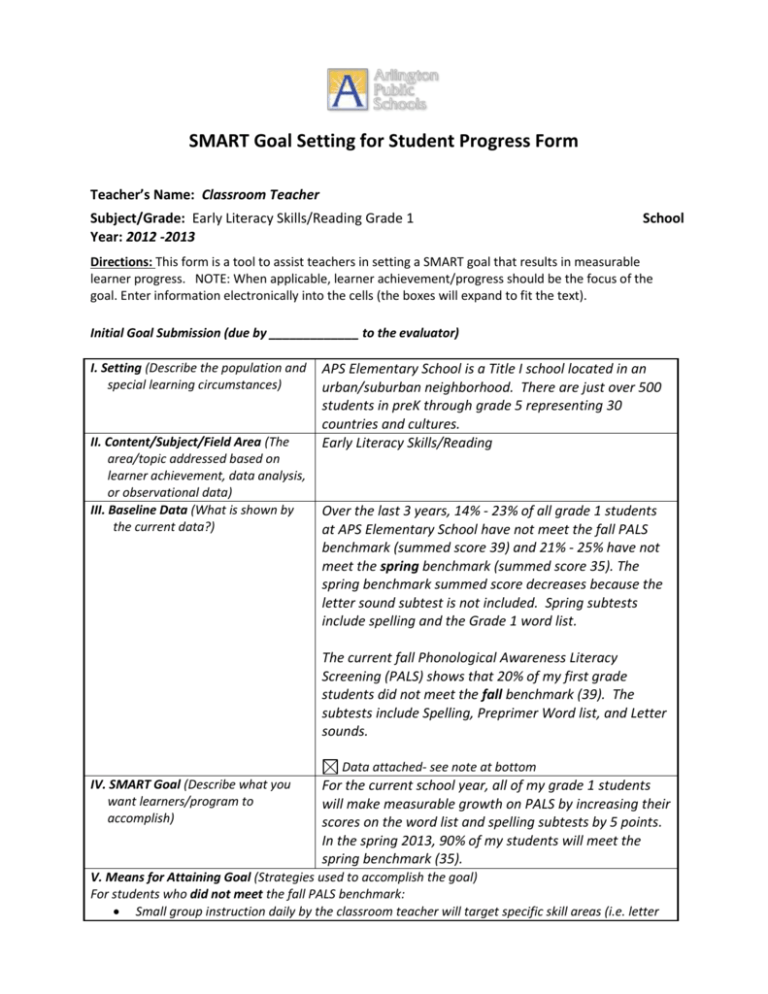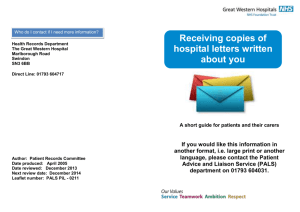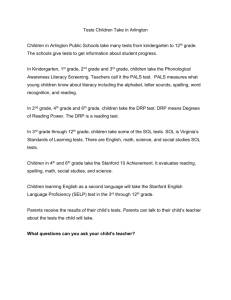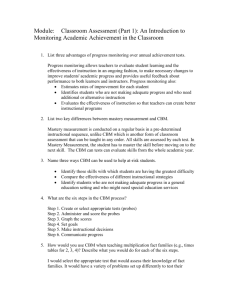SMART Goal Setting for Student Progress Form
advertisement

SMART Goal Setting for Student Progress Form Teacher’s Name: Classroom Teacher Subject/Grade: Early Literacy Skills/Reading Grade 1 Year: 2012 -2013 School Directions: This form is a tool to assist teachers in setting a SMART goal that results in measurable learner progress. NOTE: When applicable, learner achievement/progress should be the focus of the goal. Enter information electronically into the cells (the boxes will expand to fit the text). Initial Goal Submission (due by _____________ to the evaluator) I. Setting (Describe the population and special learning circumstances) II. Content/Subject/Field Area (The area/topic addressed based on learner achievement, data analysis, or observational data) III. Baseline Data (What is shown by the current data?) APS Elementary School is a Title I school located in an urban/suburban neighborhood. There are just over 500 students in preK through grade 5 representing 30 countries and cultures. Early Literacy Skills/Reading Over the last 3 years, 14% - 23% of all grade 1 students at APS Elementary School have not meet the fall PALS benchmark (summed score 39) and 21% - 25% have not meet the spring benchmark (summed score 35). The spring benchmark summed score decreases because the letter sound subtest is not included. Spring subtests include spelling and the Grade 1 word list. The current fall Phonological Awareness Literacy Screening (PALS) shows that 20% of my first grade students did not meet the fall benchmark (39). The subtests include Spelling, Preprimer Word list, and Letter sounds. Data attached- see note at bottom IV. SMART Goal (Describe what you want learners/program to accomplish) For the current school year, all of my grade 1 students will make measurable growth on PALS by increasing their scores on the word list and spelling subtests by 5 points. In the spring 2013, 90% of my students will meet the spring benchmark (35). V. Means for Attaining Goal (Strategies used to accomplish the goal) For students who did not meet the fall PALS benchmark: Small group instruction daily by the classroom teacher will target specific skill areas (i.e. letter sounds, word recognition, spelling, alphabetics, phonemic awareness) as indicated by PALS. Students will be in like groups based on instructional needs. Participation in a PALS intervention program/group with a PALS tutor 2.5 hours per week with concentration on early literacy skills (i.e. letter sounds, word recognition, spelling, alphabetics, phonemic awareness) as indicated by PALS. Student groups based on instructional needs. Instructional Strategy Evidence Target Date In-class small group differentiated instruction (target specific skill areas in need i.e. letter sounds, COW, word knowledge, spelling); groups are formed based on instructional needs as indicated on PALS Small group instruction with PALS tutor( pull-out); groups are formed based on instructional needs as indicated by PALS; students will participate in Earobics (software; multi-sensory early literacy intervention program) as well as small group targeted instruction on specific early literacy skills i.e. phonemic awareness, COW, spelling, sight words. PALS Quick Checks – given every 3 – 4 weeks on targeted skills PALS midyear and spring October, November, December, February, March, April January and May Earobics Assessment Roadmap Weekly PALS Quick Checks October, November, December, February, March, April PALS midyear and spring January and May Teacher’s Signature: Date: Evaluator’s Signature: Print or Type Evaluator’s Name: Date: Principal forwards one copy to the Professional Development Office Data attached: PALS School History Report for Grade 1: 2011, 2012, 2013 (3 year trend) PALS Student Summary Reports: fall, for students who did not meet the benchmark Additional Data attached would be: (from the PALS website but is not available at this time) PALS Class Summary Report: fall APS Elementary School A PALS Data: 3 year trend GRADE 1 # of Students Tested # Identified Students not meeting benchmark % Identified Students not meeting benchmark 2010-2011 Fall 65 15 23% 2010-2011 Spring 68 17 25% 2011-2012 Fall 75 11 15% 2011-2012 Spring 70 16 23% 2012 – 2013 Fall 90 13 14% 2012 – 2013 Spring Spring to Spring: 2011 - 2013 Grade 1









